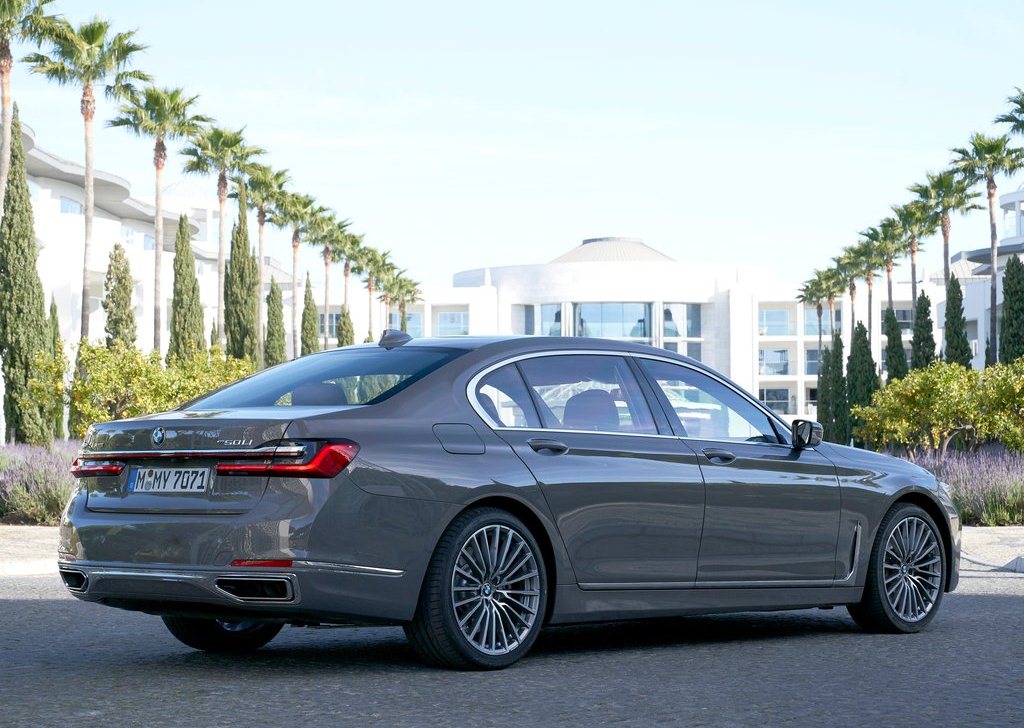Gracefully sporting proportions and a progressive interpretation of luxury mark out the exterior design of the new BMW 7-Series. Its alluring bodywork reflects the supreme dynamics and exclusive comfort that shape the luxury sedan's unmistakable driving experience. The latest edition of the 7-Series features neatly judged exterior flourishes, which underline its status and advanced technology even more intently. The design updates reach every area of the body and strengthen, above all, the confident presence with which the new BMW 7-Series sedan advertises its position as the brand's flagship model. The far-reaching exterior redesign accentuates the cultured elegance of the BMW 7-Series and takes in the front apron, bonnet, headlights, front side panels, rear bumper trim and rear lights. The BMW 7-Series will continue to be offered in two body variants. The longer version of the luxury sedan has a wheelbase extended by 14 centimetres over the standard car - to 3,210 millimetres - and gives rear-seat passengers the extra space to match. The standard 7-Series (5,120 mm) and its long-wheelbase twin (5,260 mm) are both 22 millimetres longer than their respective predecessors. The new model's width (1,902 mm) and height (1,467 mm / long-wheelbase version: 1,479 mm) remain unchanged.
Engines, transmission and BMW xDrive
The arrival of the new BMW 7-Series takes the driving pleasure experience in a luxury sedan to new heights. This is down in no small part to the array of innovations that have been incorporated into the car's powertrain technology. The new BMW 7-Series is available with petrol and diesel engines using six, eight and twelve cylinders, as well as a plug-in hybrid drive system with a brand new design offering an increased electric range, enhanced performance and lower consumption. The eight-speed Steptronic transmission fitted as standard on all model variants has also undergone further improvement, as has the BMW xDrive intelligent all-wheel-drive system that can be combined not just with the petrol and diesel engines but with the hybrid drive too. All the engines fitted in the new BMW 7-Series share a number of common denominators: an aluminium construction, optimised thermodynamics and the very latest BMW TwinPower Turbo technology. The technology package for the petrol engines comprises twin-scroll turbochargers, High Precision Injection, VALVETRONIC fully variable valve timing and Double-VANOS variable camshaft control. The diesel power units, meanwhile, feature a turbocharging system with up to four turbochargers and common-rail direct injection. To minimise particulate emissions, both the newly developed V8 unit and the V12 under the bonnet of the new BMW M760Li xDrive are now equipped with a gasoline particulate filter. The system of emission control for the diesel models employs BMW BluePerformance technology including a particulate filter, an oxidation catalyst, a NOx adsorption catalyst and an SCR catalyst with AdBlue injection to reduce nitrogen oxide emissions. Thus equipped, all model variants of the new BMW 7-Series meet the requirements of the Euro 6d-TEMP emissions standard.
Prestige plus performance: V12 engine in the BMW M760Li xDrive
Spearheading the line-up of engines for the new BMW 7-Series is the twelve-cylinder petrol unit that sets the benchmark for majestic power delivery in the luxury segment. Traditionally the most prestigious engine variant, the V12 serves up a beguiling blend of unrivalled smoothness and tremendous performance. The specimen powering the new BMW M760Li xDrive has a displacement of 6.6 litres from which it extracts a maximum output of 430 kW/585 hp between 5,250 and 5,750 rpm. The peak torque of 850 Nm (627 lb-ft) is on tap over a wide rev range extending from 1,600 to 4,500 rpm. The high-performance engine propels the remarkably sporty luxury sedan to 100 km/h (62 mph) from rest in just 3.8 seconds. The top speed of the new BMW M760Li xDrive is electronically limited to 250 km/h (155 mph), which is increased to 305 km/h (190 mph) if the optional M Driver's Package is selected. The new BMW M760Li xDrive posts combined fuel consumption of 12.5 - 12.4 litres per 100 kilometres (22.6 - 22.8 mpg imp), equating to CO2 emissions of 285 - 282 grams per kilometre. Extreme rigidity, weight optimisation and effective reduction of vibrations are the defining qualities of the V12's basic design. The all-aluminium engine's two banks of cylinders are positioned at an angle of 60 degrees to each other. On the outside of each bank there is a mono-scroll turbocharger with indirect charge air cooling and a separate cooling circuit. Emissions performance has been optimised with the help of close-coupled catalytic converters and two gasoline particulate filters. In order to reduce back pressure, the exhaust gases flow unimpeded through the twin-pipe exhaust system's rear silencer whenever the exhaust flap is open. The rear silencer combines with exhaust flap control to give the engine a broad acoustic spectrum, ranging from creamy smooth to dramatically sporty.




![2025 Volkswagen Tiguan [US]: A Redesigned Contender in the Compact SUV Segment](https://blogger.googleusercontent.com/img/b/R29vZ2xl/AVvXsEjHSbVJ8u9nDGPav1mwhuX2YcfP6k24cDq2qOtHuBatIk40RAl7qpLYM4vuwRR5PEdg5PRZBVRCjy16sbjNwDvcKLtUL0K0z6sgHVgLTjNcWPBmOpOZf4hz6jc05KelDXxqj5q4cBKaB8fVWbzdKxRqddXYeVEW5CizVW1teU_jHpgdhiKMjcLDT9WUibjY/w680/2025%20Volkswagen%20Tiguan%20%5BUS%5D_01.jpg)



![2026 Kia Sportage [EU] Review: A Refined European Crossover with Bold Style and Electrified Options](https://blogger.googleusercontent.com/img/b/R29vZ2xl/AVvXsEgqMRwJE1m90uCMgRSB6oc4bAzmAaKXJlNoCwavK5fXHaphLYY1sUVXdxUC94zuj95CdjDG2SqRnUBYMqta-dapTLIaHhzEdJAS821ldVMQOKfAZNpQlZ5fYTwKzKbKj8ad9QeKlaQPcNLRZ6zaGvuXhsg1kQ6zQCQqYtjmOM8q9u-a7Nl3WYjp773OLXJR/w680/2026%20Kia%20Sportage%20%5BEU%5D_01.jpg)





0 Comments